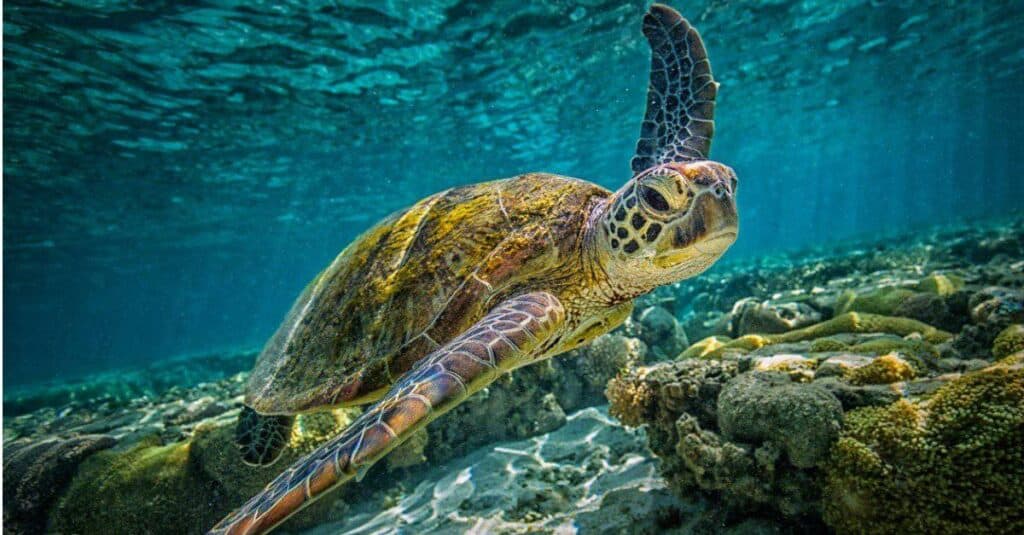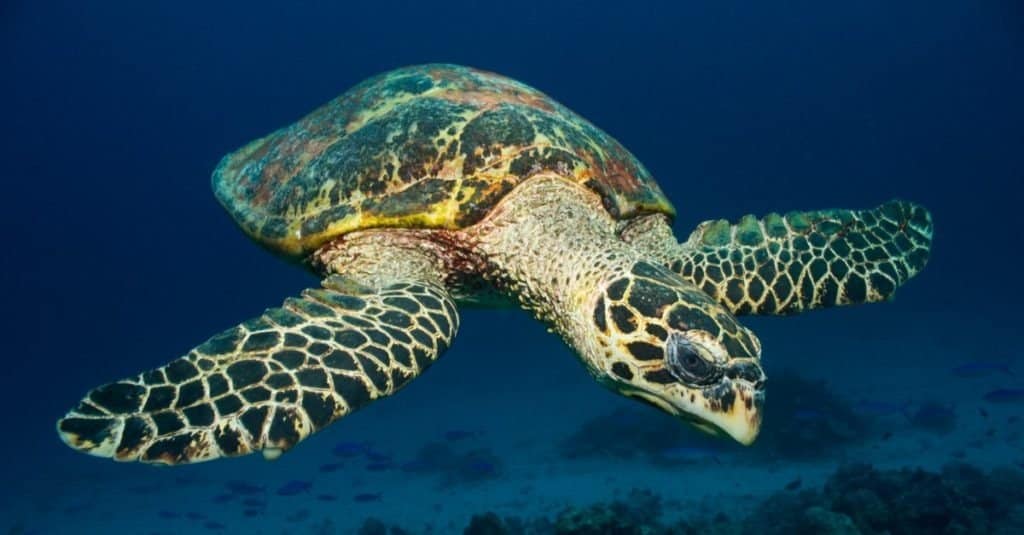Sea turtles are certainly among the most stunning and fascinating reptiles on the planet, and many animal lovers dream of getting the chance to see them up close in person. Florida’s warm coastal waters and sandy beaches provide an ideal home and nesting site for various sea turtle species. People visit the Sunshine State annually to view the turtles in their natural habitat.
However, knowing exactly where to look for them, when they hatch, and how to observe these graceful reptiles respectfully is essential for the turtles’ safety and ensuring you get the best possible experience viewing them! To help you on your turtle-seeking quest, let’s look at the different types of sea turtles in Florida. We’ll also go over where you can go to find them when they hatch and more.
What Kinds of Sea Turtles Live in Florida?

Green sea turtles are one of Florida’s five resident sea turtle species.
©iStock.com/Greg Sullavan
Thanks partly to its warm climate, comfortably subtropical waters, and expansive sandy beaches, Florida is home to five of the seven known sea turtle species. Here’s a brief overview of each species:
- Loggerhead Sea Turtle, Caretta caretta. The loggerhead has the widest geographic range of all turtle species. Its common name refers to its large, wide head and strong jaws that it uses to eat prey like mollusks and crustaceans. It has a reddish-brown shell and yellowish skin with brown splotches. Typically, it weighs anywhere from 300 to 1,000 pounds and measures between 2.5 and 3.5 feet long. Florida is its main nesting site worldwide, and it often moves between coastal waters and the open ocean.
- Leatherback Sea Turtle, Dermochelys coriacea. The leatherback is the largest of all sea turtle species and can dive deeper than any other known turtle species. It is named for its smooth, leathery dark grey shell. It ranges from 500 to 1,500 pounds on average and usually measures between 4 and 6 feet long. It mainly feeds on jellyfish and seeks deeper, cooler waters to hunt during the day and more shallow waters at night to warm up and rest.
- Green Sea Turtle, Chelonia mydas. This species is named for its unusually green body fat under its shell. It typically weighs between 300 and 400 pounds and measures 3 to 4 feet long. The turtle’s shell can range in color from olive green to reddish brown and even grey, and its skin is usually cream-colored and covered in brown splotches. Adult green turtles prefer shallow coastal areas near coral reefs and seagrass beds. However, juveniles enjoy hunting in deeper waters.
- Hawksbill Sea Turtle, Eretmochelys imbricata. This species gets its common name from its narrow, sharp beak, similar to a hawk’s. Its shell’s carapace has a mottled reddish brown and white pattern, and its skin is off-white with brown or tan splotches. Adult hawksbill turtles measure 3 to 3.5 feet and weigh 150 to 200 pounds on average. They prefer shallow waters near coral reefs, but they move between shallow water and the open ocean frequently.
- Kemp’s Ridley Sea Turtle, Lepidochelys kempii. The Kemp’s Ridley is the rarest and most endangered of all sea turtle species. It is also the smallest of all sea turtles, weighing around 50 to 80 pounds and measuring 20 to 30 inches long on average. Interestingly, it is the only sea turtle species to nest during the day. Babies are dark purplish in color, but as adults, they develop pale yellowish skin and a greyish brown or green shell. It prefers shallow coastal waters.
Now that we have a better idea of the types of turtles you can find in Florida, let’s move on to where they live and nest, and most importantly, where and how you can view them!
Where Do Florida’s Sea Turtles Live?

The hawksbill sea turtle lives the furthest south of all of Florida’s sea turtles.
©John Back/Shutterstock.com
Each of Florida’s five sea turtle species has its preferred type of habitat, geographical range, and nesting sites. If you’re heading to the Sunshine State and planning on observing any of these turtles, you’ll definitely want to know the best places to find them!
Here’s an overview of where all of Florida’s sea turtles reside as well as their nesting locations:
- Loggerhead Sea Turtles: As the most common sea turtle species in Florida, the loggerhead is one of the easiest to locate and observe. It primarily nests in Florida along its southeastern coast, and its largest nesting sites are in Palm Beach and Brevard counties.
- Leatherback Sea Turtles: Leatherbacks have many nesting sites along Florida’s east coast. They mainly nest in Martin, Palm Beach, and St. Lucie counties. They generally nest at a new beach instead of returning to the same site each season. Due to their soft and vulnerable shells, leatherbacks avoid coral reefs. They also prefer beaches with soft sand and a shallow means of reaching land.
- Green Sea Turtles: This species also primarily swims and nests along Florida’s southeast coast. It is most commonly found in and around Brevard county, though it can nest along most of the state’s coastline. Female green sea turtles return to the same nests yearly, laying three clutches of around 110 eggs per year on average.
- Hawksbill Sea Turtles: The hawksbill prefers the warmest and most tropical waters of all sea turtle species. It also lives and nests the furthest south of all of them. In Florida, it mainly lives amongst the coral reefs in the Keys, and it also has nesting beaches along Florida’s southeast coast in Palm Beach county.
- Kemp’s Ridley Sea Turtles: Though most of the Kemp’s Ridley turtle’s nests are in Rancho Nuevo, Mexico, it also sometimes nests in Brevard, St. Johns, and Volusia counties in Florida. Because it is the rarest and most endangered sea turtle species, its numbers and nests in Florida are very limited.
When Do Sea Turtles in Florida Hatch?

Most baby sea turtles take between 45 and 70 days to hatch.
©zulkamalober/Shutterstock.com
If you want to see baby sea turtles, you should also know when each of Florida’s sea turtle species nests and, by extension, when their clutches typically hatch. Like the previous sections, here’s an overview of each species’ nesting schedules.
- Loggerhead Sea Turtle Nesting: Loggerhead sea turtles nest in Florida from April to September yearly and peak in June. Every two weeks, female loggerheads will surface onto the sand and lay a clutch of around 100 eggs. Their eggs take around 45 to 55 days to hatch, and loggerheads do this four times per year on average. Female loggerheads return to their nests every two years to repeat the process.
- Leatherback Sea Turtle Nesting: Leatherbacks nest in Florida from March to July yearly. They nest every 2 to 3 years, and females lay clutches of around 100 eggs up to 9 times a season. Their eggs take roughly 60 days to hatch.
- Green Sea Turtle Nesting: Green sea turtles nest in Florida from June to September yearly. Female turtles return to the same nests yearly and lay 3 clutches of around 110 eggs yearly. Their eggs take around 60 days to hatch.
- Hawksbill Sea Turtle Nesting: Hawksbill turtles nest in Florida from June to August yearly. Females lay 3 to 6 clutches of around 140 eggs every season. Hawksbill eggs take around 55 to 70 days to hatch.
- Kemp’s Ridley Sea Turtle Nesting: Kemp’s Ridley turtles nest in Florida from April to July. Females lay clutches of around 100 eggs 2 to 3 times per season. Due to their poor eyesight, they nest during the day rather than at night, like most sea turtle species. Their eggs take roughly 55 days to hatch.
Where To Watch Florida’s Sea Turtles: The Best Locations

Guided turtle walks and public hatchling releases provide a safe and respectful means of observing baby sea turtles.
©IrinaK/Shutterstock.com
There are many ways to responsibly and safely observe sea turtles in Florida. These include guided turtle walks, public hatching releases, and even nest hatch success evaluations conducted by various animal conservation groups. These opportunities are the best for watching sea turtles of all species, as they are conducted and guided by professional conservationists and biologists who study the turtles extensively.
In terms of the best general location for viewing, Palm Beach and Brevard counties are key nesting sites for all of Florida’s sea turtle species. The southeastern Florida region is also home to several research and conservation facilities and groups hosting events like turtle walks and hatching releases.
Remember that, for most guided turtle walks, you’ll need to make reservations before the upcoming nesting season to secure your spot. These walks are usually hosted between May through August, and most occur at night since most sea turtle species (aside from the Kemp’s Ridley) nest at night.
The Sea Turtle Preservation Society has two locations dedicated to rehabilitating and studying sea turtles in Indiatlantic, FL, and Cape Canaveral, FL. They also host turtle walks, educational seminars, and beach clean-up events for volunteers wanting to learn more about Florida’s sea turtles.
The Florida Oceanographic Society is located in Stuart, Florida. Similarly, it conducts guided turtle walks and hosts its facility for rehabilitating sea turtles.
Finally, Fort Lauderdale’s Museum of Discovery and Science also hosts turtle walks yearly and educational events about Florida’s sea turtle population.
If you’re interested in finding even more locations to view sea turtles, the Florida Fish and Wildlife Conservation Commission also lists more sea turtle viewing opportunities at MyFWC.com.
The photo featured at the top of this post is © iStock.com/Greg Sullavan
Thank you for reading! Have some feedback for us? Contact the AZ Animals editorial team.






